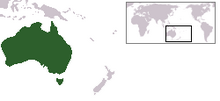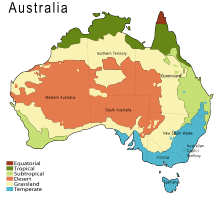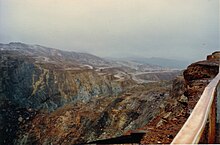
A drought is defined as drier than normal conditions. This means that a drought is "a moisture deficit relative to the average water availability at a given location and season". A drought can last for days, months or years. Drought often exerts substantial impacts on the ecosystems and agriculture of affected regions, and causes harm to the local economy. Annual dry seasons in the tropics significantly increase the chances of a drought developing and subsequent wildfires. Periods of heat can significantly worsen drought conditions by hastening evaporation of water vapour.
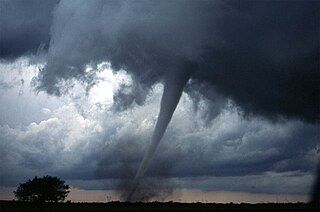
Extreme weather or extreme climate events includes unexpected, unusual, severe, or unseasonal weather; weather at the extremes of the historical distribution—the range that has been seen in the past. Often, extreme events are based on a location's recorded weather history and defined as lying in the most unusual ten percent. The main types of extreme weather include heat waves, cold waves and tropical cyclones. The effects of extreme weather events are seen in rising economic costs, loss of human lives, droughts, floods, landslides and changes in ecosystems.

The Great Barrier Reef is the world's largest coral reef system composed of over 2,900 individual reefs and 900 islands stretching for over 2,300 kilometres (1,400 mi) over an area of approximately 344,400 square kilometres (133,000 sq mi). The reef is located in the Coral Sea, off the coast of Queensland, Australia, separated from the coast by a channel 100 miles wide in places and over 200 feet deep. The Great Barrier Reef can be seen from outer space and is the world's biggest single structure made by living organisms. This reef structure is composed of and built by billions of tiny organisms, known as coral polyps. It supports a wide diversity of life and was selected as a World Heritage Site in 1981. CNN labelled it one of the seven natural wonders of the world in 1997. Australian World Heritage places included it in its list in 2007. The Queensland National Trust named it a state icon of Queensland in 2006.

The effects of climate change span the impacts on physical environment, ecosystems and human societies due to human-caused climate change. The future impact of climate change depends on how much nations reduce greenhouse gas emissions and adapt to climate change. Effects that scientists predicted in the past—loss of sea ice, accelerated sea level rise and longer, more intense heat waves—are now occurring. The changes in climate are not uniform across the Earth. In particular, most land areas have warmed faster than most ocean areas, and the Arctic is warming faster than most other regions.. The regional changes vary: at high latitudes it is the average temperature that is increasing, while for the oceans and tropics it is in particular the rainfall and the water cycle where changes are observed. Global warming changes regional climate via the melting of ice, changes in the hydrological cycle and changing currents in the oceans.

The extinction risk of climate change is the risk of species becoming extinct due to the effects of climate change. Climate change is the long-term conversion of temperature and average weather patterns. Currently, 19% of species on the IUCN Red List of Threatened Species are already being impacted by climate change. Many studies have been conducted on how climate change can affect global temperatures and environment. Studies done by the Intergovernmental Panel on Climate Change (IPCC) show that it is estimated that the temperature will rise from about 1.4 to 5.5 degrees Celsius within the next century. Temperature rise of 1.5 °C to 2.0 °C may see the geographic range of many insects, plants and vertebrates decrease significantly. Efforts like Paris Agreement attempt to reduce further warming and help ecosystems adapt to the effects of rising temperatures.
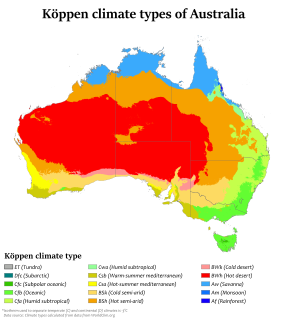
Australia's climate is governed mostly by its size and by the hot, sinking air of the subtropical high pressure belt. This moves north-west and north-east with the seasons. The climate is variable, with frequent droughts lasting several seasons, thought to be caused in part by the El Niño-Southern Oscillation. Australia has a wide variety of climates due to its large geographical size. The largest part of Australia is desert or semi-arid. Only the south-east and south-west corners have a temperate climate and moderately fertile soil. The northern part of the country has a tropical climate, varying between grasslands and desert. Australia holds many heat-related records: the continent has the hottest extended region year-round, the areas with the hottest summer climate, and the highest sunshine duration.

Natural catastrophe in India, many of them related to the climate of India, cause massive losses of life and property. Droughts, flash floods, cyclones, avalanches, landslides brought by torrential rains, and snowstorms pose the greatest threats. A natural disaster might be caused by earthquakes, flooding, volcanic eruption, landslides, hurricanes etc. In order to be classified as a disaster, it will need to have a profound environmental effect and/or human loss and frequently incurs a financial loss. Other dangers include frequent summer dust storms, which usually track from north to south; they cause extensive property damage in North India and deposit large amounts of dust and dirt from arid regions. Hail is also common in parts of India, causing severe damage to standing crops such as rice and wheat and many more crops.

Land clearing in Australia describes the removal of native vegetation and deforestation in Australia. Land clearing involves the removal of native vegetation and habitats, including the bulldozing of native bushlands, forests, savannah, woodlands and native grasslands and the draining of natural wetlands for replacement with agriculture, urban and other land uses.
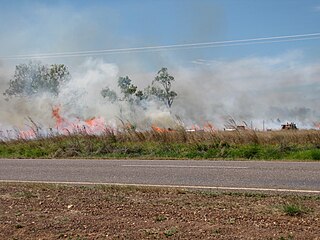
Climate change in Australia has been a critical issue since the beginning of the 21st century. Australia is becoming hotter and more prone to extreme heat, bushfires, droughts, floods, and longer fire seasons because of climate change. Since the beginning of the 20th century, Australia has experienced an increase of over 1.4 °C in average annual temperatures, with warming occurring at twice the rate over the past 50 years as in the previous 50 years. Recent climate events such as extremely high temperatures and widespread drought have focused government and public attention on the effects of climate change in Australia. Rainfall in southwestern Australia has decreased by 10–20% since the 1970s, while southeastern Australia has also experienced a moderate decline since the 1990s. Rainfall is expected to become heavier and more infrequent, as well as more common in summer rather than in winter. Water sources in the southeastern areas of Australia have depleted due to the increasing population in urban areas coupled with a persistent prolonged drought.

Climate change is a long-term change in the average weather patterns that have come to define Earth’s local, regional and global climates. These changes have a broad range of observed effects that are synonymous with the term. Climate change is any significant long term change in the expected pattern, whether due to natural variability or as a result of human activity. Predicting the effects that climate change will have on plant biodiversity can be achieved using various models, however bioclimatic models are most commonly used.

The Paroo-Darling National Park is a protected national park that is located in the Far West region of New South Wales, in eastern Australia. The 178,053-hectare (439,980-acre) national park spans two distinct regions in the outback area. This region covers the arid catchments of the Paroo River and the Paroo-Darling confluence to the south.

Climate change in Sri Lanka is an important issue, and its effects threaten to impact both human and natural systems in Sri Lanka. Roughly 50 percent of its 22 million citizens live in low-lying coastal areas in the west, south, and south-west of the island, and are at risk of future sea level rise. Climate change also threatens the island's biodiversity, including its marine ecosystem and coastal coral reef environments. Sea-level rise due to climate change has the potential to affect the overall abundance of endemic species. Sri Lanka's coastal regions, such as the Northern Province and the Northern Western Province, are considered major hotspots and extremely vulnerable to climate change. These maritime provinces are the most densely populated. In addition to being a threat to Sri Lanka's biodiversity, climate change may cause disastrous consequences on various levels in such areas. Such consequences include: Affecting agricultural productivity, causing natural disasters like floods and droughts, increasing the spread of infectious illnesses, and finally undermining the living standards.

The effects of climate change on human health include direct effects of extreme weather, leading to injury and loss of life, as well as indirect effects, such as undernutrition brought on by crop failures or lack of access safe drinking water. Climate change poses a wide range of risks to population health. The three main categories of health risks include: (i) direct-acting effects, (ii) impacts mediated via climate-related changes in ecological systems and relationships, and (iii) the more diffuse (indirect) consequences relating to impoverishment, displacement, and mental health problems.
Climate change in Guam encompasses the effects of climate change, attributed to man-made increases in atmospheric carbon dioxide, in the U.S. territory of Guam.

Climate change in Nebraska encompasses the effects of climate change, attributed to man-made increases in atmospheric carbon dioxide, in the U.S. state of Nebraska.

Climate change in Puerto Rico encompasses the effects of climate change, attributed to man-made increases in atmospheric carbon dioxide, in the U.S. territory of Puerto Rico.

Climate changein the Caribbean poses major risks to the islands in the Caribbean. The main environmental changes expected to affect the Caribbean are a rise in sea level, stronger hurricanes, longer dry seasons and shorter wet seasons. As a result, climate change is expected to lead to changes in the economy, environment and population of the Caribbean. Temperature rise of 2 °C above preindustrial levels can increase the likelihood of extreme hurricane rainfall by four to five times in the Bahamas and three times in Cuba and Dominican Republic. Rise in sea level could impact coastal communities of the Caribbean if they are less than 3 metres (10 ft) above the sea. In Latin America and the Caribbean, it is expected that 29 – 32 million people may be affected by the sea level rise because they live below this threshold. The Bahamas is expected to be the most affected because at least 80% of the total land is below 10 meters elevation.

Climate change in the Philippines is having serious impacts such as increased frequency and severity of natural disasters, sea level rise, extreme rainfall, resource shortages, and environmental degradation. All of these impacts together have greatly affected the Philippines' agriculture, water, infrastructure, human health, and coastal ecosystems and they are projected to continue having devastating damages to the economy and society of the Philippines.

Climate change in Madagascar is a significant threat to the country's environment and people. Climate change is resulting in average temperatures in Madagascar becoming hotter, with longer dry seasons and more intense tropical storms. The country's unique ecosystems, animal and plant life are being impacted. Madagascar's population is highly vulnerable due to severe impacts on water and agriculture in Madagascar, with implications for food security and health.

Climate change in Fiji is an exceptionally pressing issue for the country - as an island nation, Fiji is particularly vulnerable to rising sea levels, coastal erosion and extreme weather. These changes, along with temperature rise, will displace Fijian communities and will prove disruptive to the national economy - tourism, agriculture and fisheries, the largest contributors to the nation's GDP, will be severely impacted by climate change causing increases in poverty and food insecurity. As a party to both the Kyoto Protocol and the Paris Climate Agreement, Fiji hopes to achieve net-zero emissions by 2050 which, along with national policies, will help to mitigate the impacts of climate change.
